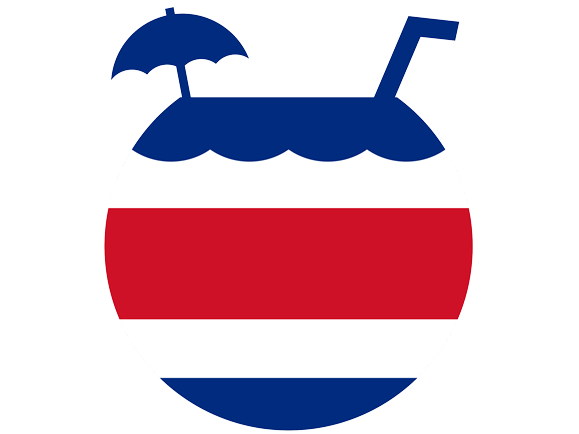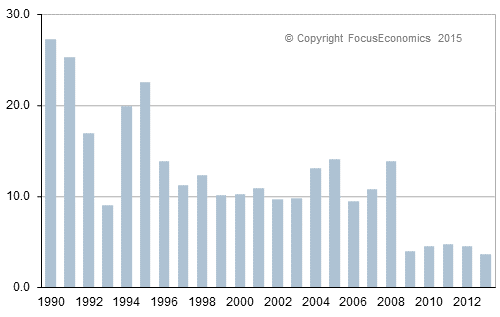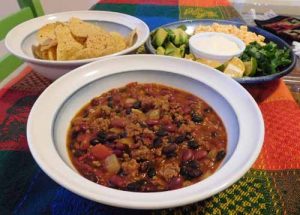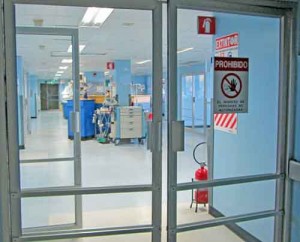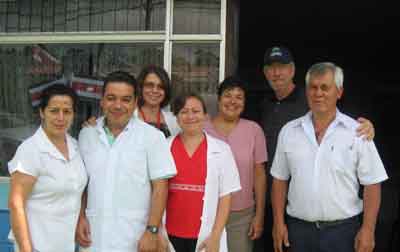Cost of Living
Retire for Less in Costa Rica – March 11, 2020
Welcome to our Retire For Less In Costa Rica Newsletter
In This Issue:
- What’s Up with the Yeatmans?
- Our January 2020 Costa Rica Cost of Living
- Inflation in Costa Rica (updated 3/10/2020)
- This Retirement Life Interview
- Some Reasons Why We Invested Our Savings in Coopenae (updated with current data)
- Featured Property in Lake Arenal: Small Low Maintenance Home in San Luis-$89,000
- Cooking in Costa Rica: An Expat’s Guide to Buying Groceries, Cooking and Eating in Costa Rica
- Our Ultimate CR Healthcare Tour
What’s Up with the Yeatmans?
by Gloria
You haven’t heard from us in a while and some of you have been concerned about us. Thank you for that. We appreciate your kind thoughts so much. We are doing well!
We arrived back in Costa Rica on January 8th after living in Mexico for six months. Since then, we have had a flurry of medical appointments and tests, mostly for Paul as a follow-up to his cancer surgery 18 months ago. So far, so good. All of his tests have been clear and just need to be repeated in a year or so. I have also had my regular diagnostic checks and everything looks good as well. This getting older is not for the faint of heart!
Many of you have noticed that our newsletters have not been monthly as they were for so many years. Part of the change was due to us being out of the country for six months; it’s hard to write a newsletter about daily life in Costa Rica when you are living in another country. But part of the change is also…frankly…I’m just getting tired. It has been a big commitment; we have been faithfully writing our newsletter at least once a month since April 2011.
We have tried to keep it interesting and to share helpful information about daily living as expats in Costa Rica. And in reviewing our past posts, there are many that need to be updated with current prices and data. So, the good news is that we have decided to publish the information on our website in book form, with all updated and current information. The bad news is that we will no longer be sending out monthly newsletters. This isn’t the last newsletter you will receive from us though. We will keep you posted for a while with our Costa Rica cost of living reports, updates on how the book is coming along, and other info we think you will find helpful…just not every month.
We want to thank our readers, especially those who have followed us for so many years. It is a privilege to share our lives with you and to hear back from so many of you that our posts have been helpful in your own expat journeys.
Our January 2020 Costa Rica Cost of Living
by Gloria
January was a transition month for us. After living in Oaxaca, Mexico for six months, we started out the new year with a trip to Morelia, Michoacan, Mexico, before returning to Costa Rica on January 8th. Obviously, that increased our expenses for the month. Our total spending was $2,617.17. Here’s the breakdown of our vacation spending and our Costa Rica spending once we returned home:
Transportation – $547.20 (Mexico: $545.92 + Costa Rica: $1.28)
We came home to a car with a full gas tank and in good shape, thanks to our friend, Bill, who was subletting our apartment and car in Costa Rica. Since we walk most places in town, our CR transportation expenses were limited to a few tolls for the month of January.
The bulk of our spending was for transportation within Mexico and our return flight from Mexico City to San Jose, Costa Rica. Round-trip first-class bus fare from Mexico City to Morelia and back for the two of us totaled $70.86 USD. This was for two seats on the upper deck of a luxurious bus with great visibility, individual movie screens, controls, and headphones, wide, reclining seats and a bathroom on-board. The trip took four hours each way.
Our one-way flight home from Mexico City on Interjet cost $356.58 and included the cost of one extra bag.
The rest of our Mexico transportation expenses included Ubers to and from bus stations and the airport, a taxi tour of the city of Morelia, and a taxi tour from Morelia to Patzcuaro and back.
Groceries – $513.23 (Mexico: $5.91 + Costa Rica: $507.32)
Other than a few miscellaneous purchases while traveling in Mexico, 99% of our grocery expenses for the month of January consisted of restocking all of our normal foods in Costa Rica. This, of course, meant a trip to PriceSmart to buy large bags of nuts and chocolate chips for baking, blocks of cheese we can’t get locally, olive oil, balsamic vinegar, and a few other things. PriceSmart carries quite a few Kirkland brand products. Then there were multiple trips to the grocery stores and the weekly feria to buy fresh fruits and veggies and everything else. I have to admit that the total we spent on groceries for the month is a bit staggering to me!
Meals Out – $373.29 (Mexico: $254.59 + Costa Rica: $118.69)
When we travel, we eat well, though usually inexpensively. Our six days in Morelia and one day in Mexico City totaled $254.59 for two to three meals a day. We averaged, for the two of us, $36.37 per day. We tend to eat where the locals eat and have found that it is much less expensive to eat out in Mexico than in Costa Rica, by 50% or more.
Once we returned to Costa Rica, we also returned to our habit of eating at home for most meals. When we ate out, three lunches and four dinners out came to $118.69. All were at casual restaurants, including our favorites, Filipos and Savory a la Thai. We also discovered Green Garden, a new Italian eatery in San Ramon (the owner/chef had worked in New York’s Little Italy for 10 years) and we ate there a couple of times.
Healthcare – $175.18 (Mexico: $105.85 + Costa Rica: $69.33)
Traveling is hard on our bodies! There was too much recirculated air-conditioned air, sitting on buses and planes, and generally being in public where there were always some sick people. Paul was sick with a bad cold and lots of sneezing the first week of January, and then it was my turn to get the dreaded gripe on our return flight home, though mine was accompanied by lots of coughing. We saw the “box doctor” in Morelia a couple of times — a doctor that works at pharmacies who will examine you and write prescriptions for medications that you can then buy in the pharmacy — and bought lots of cold meds. I also woke up one morning with terrible back pain (probably from all of the traveling and sitting) and went for a therapeutic massage while in Mexico.
After our return to Costa Rica on the 8th, our healthcare expenses included more cold meds and our monthly Caja payment. They did not include the pro-rated monthly amount we normally pay for our annual Medismart plan since it had lapsed in December and we didn’t renew it until February.
Rent/Phone/Utilities – $705.45 (Mexico: $5.33 + Costa Rica: $700.12)
Our only expense in this category while in Mexico was one more week of phone service on our Telcel sim cards. Everything else was to cover our Costa Rica expenses as broken down here:
Our friend, Bill, had already paid the Internet for the month and the electricity bill was for December’s usage so he paid that as well; therefore our expenses do not include these amounts. Housecleaning expenses were for three days of four hours each to clean our 1100 s.f. apartment. Phone expenses were higher than normal as I needed a new case and glass cover (about $21 USD) for my smartphone. The rest of the phone expenses were for our “pre-pay” Kolbi sim cards and our monthly Vonage line.
Pet Care & Supplies – $2.12 (Costa Rica)
Our kitty, Laura, was fully stocked with kibble and litter when we returned to Costa Rica so our only expense in January was for a package of treats. It took her a few days to get used to us being back. Six months is a long time to be separated! But she was in great hands with Bill and has become a kind of a shared kitty.
Personal Care and Clothing – $0
Entertainment & Travel – $244.06 (Mexico: $228.25 + Costa Rica: $15.81)
While in Mexico, expenses in this category were for hotel accommodations — six nights in Morelia at Hotel El Carmen ($33.25/night) and one night in Mexico City at Hotel Embassy ($28.77).
In Costa Rica, our only other entertainment expenses were our monthly Netflix bill (now $13.81/month), Paul’s subscription to the Baltimore Sun online ($2.00).
Miscellaneous – $14.92 (Mexico)
What’s a vacation without souvenirs? On our day trip to Patzcuaro from Morelia, we stopped in the town of Santa Fe de Laguna to visit a potter’s workshop. While he had some beautiful and very different pieces, I resisted the temptation and walked away with just a traditional necklace (100 pesos, about $5 USD), earrings, and a gift for a friend. Here’s a picture of the necklace, with a close-up of the little mugs, each individually painted and glazed. So cute and colorful!
Postage – $11.15 (Costa Rica)
It was time again to renew our post office box. The fee has gone up every year and, this year, the fee for 12 months was 18,927.5 colones (about $33 USD). Since we share our post office box with two others, we each pay 1/3 of the fee, so ours came to $11.15. None of us gets very much mail and we each have a key to the box so it has worked out well for all of us.
Services – $30.58 (Mexico: $24.40 + Costa Rica: $6.18)
In the Services category, our Mexico expenses were for baggage handling as we traveled and lavanderia charges to have our clothes washed and ironed if needed.
In Costa Rica, we launder our clothes ourselves (this is one of Paul’s “low tech” chores) and send them out to be ironed by a local lady for less than $1 USD per piece.
As usual, to help put things into perspective, here are our expenses for the previous two months reported (May and June were our last two months in Costa Rica before we left for Mexico in July 2019). If you want more information about a particular month, just click on the graphic for that month below:
Related Articles:
- Paul’s Monthly Tip to Live for Less in Costa Rica: Rent a Post Office Box
- MediSmart: An Affordable Alternative to Private Health Insurance in Costa Rica
Inflation in Costa Rica
(Updated 3/10/2020)
Latin America has a reputation for having high inflation. All in all, I would say that’s an accurate assumption. So let’s take a historical look at Costa Rica’s inflation since 1990.
Previous to the year 2009, inflation in Costa Rica was very high, with some years over 20% (see the graph below).
Costa Rica Inflation Chart
Source: https://www.focus-economics.com/country-indicator/costa-rica/inflation
Their most up-to-date inflation chart includes the years 2000 to 2016:
Since we moved to Costa Rica in 2009, the country has kept inflation under control; in fact, the inflation rate in 2016 was zero:
So how did inflation affect our cost of living? Although our cost of living in Costa Rica has gone up every year, we haven’t let inflation affect us. We just assume costs are going up about 5% and don’t pay any attention to it, until 2015, when the inflation rate was less than 1%. It’s been a good thing. For instance, the price of gas went down considerably in 2015, to as low as $3.90 a gallon (although in 2016 it rose to over $4.25/gallon and is now $4.28/gallon in March 2020). I now drive about 5,000 miles per year, which is more than most, and a lot for someone living in Costa Rica.
 Over the years, the greatest uptick in our costs was not caused by inflation, but rather by ourselves. We’ve gradually loosened our purse-strings and spent money a little more easily as our financial position has improved.
Over the years, the greatest uptick in our costs was not caused by inflation, but rather by ourselves. We’ve gradually loosened our purse-strings and spent money a little more easily as our financial position has improved.
Ten or eleven years ago, we were more frugal and cautious about our spending, but today we are likely to buy more freely and just flip the item in our shopp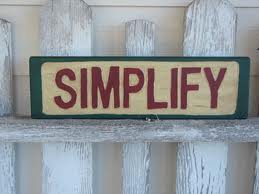 ing cart. Luckily, Gloria and I are on the same page about money. We both tend to be frugal. It’s just our normal, natural, way of being. We can’t help it. Like many seniors (I’m now 73 and Gloria is 63) and “retirees”, we wanted to scale down and simplify. Living in “luxury” was never in our DNA. Even now, my monthly Social Security payment is only $1074 and Gloria collects a small pension of $152 so it’s good that we have that outlook, right?
ing cart. Luckily, Gloria and I are on the same page about money. We both tend to be frugal. It’s just our normal, natural, way of being. We can’t help it. Like many seniors (I’m now 73 and Gloria is 63) and “retirees”, we wanted to scale down and simplify. Living in “luxury” was never in our DNA. Even now, my monthly Social Security payment is only $1074 and Gloria collects a small pension of $152 so it’s good that we have that outlook, right?
We know, for many, the cost of living is the most important consideration regarding living abroad, but for us, even with only a small Social Security check of $922 in 2009, it was not. Therefore, inflation never figured into the math. I guess if inflation returned to the pre-2009 levels, it might be a major consideration, but so far, so good. We’re permanent residents and plan to keep our legal residency in our adopted country, but we still intend to keep our options open.
Related Articles:
- Our 2016 Annual Cost of Living in Costa Rica Summary
- Increasing Grocery Prices in Costa Rica: Fact or Fiction?
This Retirement Life Interview
We were recently interviewed by Dave Hogan from This Retirement Life. Dave and his wife, Kathy, visited Costa Rica for the first time last month on a Caravan Tour, which they thoroughly enjoyed. “Kathy and I had a wonderful time in Costa Rica on our 9-day Caravan Tour. What a beautiful country and what friendly people!” Dave wrote.
Dave wanted to interview us to learn about our retirement lives in this beautiful country. The interview was just published on their blog and you can read it in its entirety at Retiring to Costa Rica: One Expat Couple’s Story. In the meantime, here is a shortened version which we are reprinting with their permission:
More North Americans are choosing to retire abroad, and one of the most popular spots is Costa Rica, in nearby Central America. In the latest annual survey by International Living, Costa Rica ranked No. 3 in a list of the top 20 countries in the world for retiring abroad, following Panama and Portugal.
According to the U.S. Social Security Administration, more than half a million U.S. citizens receive Social Security checks outside the United States. By some estimates, as many as 70,000 North Americans live in Costa Rica, and many more go there as winter snowbirds or frequent tourists.
Few North Americans know Costa Rica as well as Paul and Gloria Yeatman, authors of the popular blog, Retire for Less in Costa Rica. They retired in 2009, moving from Baltimore, Maryland, to San Ramon de Alajuela, a small town in Costa Rica’s beautiful Central Valley. Since that time, they have conducted more than 300 tours for North Americans and Europeans considering retiring to Costa Rica. Gloria has written a book, Cooking in Costa Rica, that is available on Amazon. They are currently working on a second book.
This Retirement Life had the pleasure recently of talking with Paul and Gloria. Their comments will be invaluable to anyone considering retiring to Costa Rica or who just wants to know more about this unique and exotic country. Here are excerpts from that interview:
Q: Why are so many U.S. and Canadian retirees moving to places like Costa Rica?
Gloria: People come for a variety of reasons. For us, we wanted something different, we wanted to have a different life and do a little bit of exploring. Sometimes people come here because they are looking to live a higher level of life for less money and they think they can do it in Costa Rica or some other place. Usually those people get pulled into the idea of living in paradise for very little money. (On our tours) we never talk about paradise, other than to say there is no place that is 100 percent paradise.
Q: Should you retire to Costa Rica because it’s cheaper than living as a retiree in the U.S. or Canada?
Paul: We tell people on our tours if that (cost of living) is the main reason they are coming here, they probably won’t make it. You have to have a sense of adventure and an interest in other cultures. This idea of coming here just because it’s cheaper may not be the best idea. I look at it (lower cost of living) as a bonus.
Gloria: Not being able to afford to live in the (United) States is a reality for a lot of people, and healthcare is a big part of that. If you have enough to qualify for legal residency, then you have to join the public healthcare system, which is referred to as Caja. There are no pre-existing condition exclusions and there’s no age limit. What you pay, typically $75 to $100 per month for a retired expat couple, is based on the income you used to qualify for residency. (Note: Costa Rica requires at least $1,000 in monthly income from sources such as Social Security or pensions in order to qualify for residency).
Q: Healthcare is a concern for retirees. How is the quality and availability of healthcare in Costa Rica?
Gloria: When you look at the mix of public and private options, we’re extremely pleased with the healthcare.
Paul: We’ve had two surgeries here, both in the state (public) system. She had outpatient surgery, a pretty serious one because they thought it might be cancer, and I had my right kidney taken out. I was in the hospital for 13 days.
Q: Why did you two choose to live in the Central Valley?
Paul: We’re at a higher elevation, around 3,500 feet above sea level, so the climate is moderate, year-round. We have no need for air conditioning or heat, which keeps our costs down. In Baltimore, our utility bills were sometimes as high as $350 a month. Hospitals and shopping in the capital city of San Jose are just over an hour away, and the beach is only an hour’s drive.
Q: Whether we’re talking about Florida or Costa Rica, lots of retirees move there, find out it’s not for them, and then move back. Why do North Americans leave Costa Rica?
Gloria: The number one reason people go back is for family – kids, grandkids, and parents who are elderly. The second reason is for medical stuff. They don’t speak enough Spanish to feel comfortable using the socialized medical system here, or they have a health condition that can’t be treated here. You’re talking a small country, the size of West Virginia. They do most things well, but there there are some things they just can’t do here.
Paul: Most (medical) things they can do here. 99.5 percent, they do great.
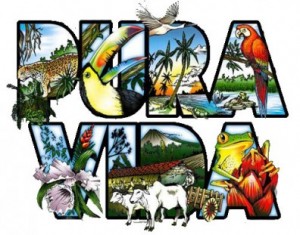 Q: What advice do you have for North Americans or Europeans who want to consider Costa Rica for their retirement?
Q: What advice do you have for North Americans or Europeans who want to consider Costa Rica for their retirement?
Paul: The longer they can come down here on a trial basis, the better. If you can come down for a month, fine. If you can come down for six months, that’s better. If after six months you decide this isn’t for you, you’ve saved yourself a ton of money.
Q: Many people move to a new place like Costa Rica and immediately buy real estate. What is your advice?
Paul: We don’t even show them real estate on our tours. We recommend they rent, at least for the first year, until they get to know the country and see if they like it. Living somewhere is different from vacationing there. It’s the dream versus the reality; the expectations versus the reality. We are the voice of common sense. We’re going to show them the good, the bad and the ugly.
Q: You’ve now lived in Costa Rica for more than a decade. Any regrets? Would you do it again?
Gloria: Would I do it all over again? In a minute. I have no regrets for doing what we did, leaving the U.S. We weren’t running from the U.S.; we were going to a new experience.
Paul: At the end of the day, I love it. I love the whole international life. It’s so much fun; it’s so interesting. I’m living my dream, and I’m thrilled with it.
 Some Reasons Why We Invested Our Savings in Coopenae
Some Reasons Why We Invested Our Savings in Coopenae
Updated March 9, 2020
We have invested in certificates of deposit with Coopenae for almost nine years now, have been very pleased with our return, and wanted to share the updated info with you for your consideration (see disclaimer below).
Why invest in Coopenae?
by Asdrúbal Zamora Corrales
In Costa Rica there are several supervised credit unions, most of which are local and very small. Each credit union has very different financial numbers. Coopenae is the Teachers & Public Employees Credit Union, the largest credit union and the most well-known among all. We provide internet services to several other financial institutions in Costa Rica. We are the safest place to invest in certificates of deposit (CDs) among all financial markets in Costa Rica.
Coopenae offers you three impressive benefits:
Safety, lowest financial risk in Costa Rica and good interest rates, also personalized English service all over the country by Asdrubal Zamora Corrales. Coopenae has 24 branches across the country.
Most relevant aspects:
- Rated by: one of top 3 and well-known international US rating companies (Fitch Ratings)
- Short term: F1 (+) : best possible rate, (+) means an outstanding liquidity,
- Long term: AA- : between AA and AAA.
- Supervised by: the Costa Rica Government through SUGEF (General Superintendence of Financial Entities): global qualification: rated within 1.03 and 1.10 for the last 15 years, where 1.00 is the best possible financial rate in Costa Rica and 4.00 the worst.
- Audited by: one of top 3 and well-known US international audit companies (Deloitte – Dec. 2019, a well-known worldwide bank audit US Company).
- Ranking:
- Within top 6 ranked credit unions in Latin America (Assets)
- Within top 4 ranked private financial companies in Costa Rica (Equity)
- Within top 3 ranked most profitable private financial companies in Costa Rica.
- Credit default rate: has been very low for the last 20 years
- Capital Adequacy Ratio (CAR): has been over 18% for the last 20 years, which means your money is there when you need it.
- Members: more than 140,664 members as of December 2019
- Target market: government employees (all government sectors)
- Experience: more than 54 years in the local financial market in Costa Rica
- Target market:
- Loans: personal loans mostly to government employees (our average personal loan rate is 17.5%)
- Savings: interest rates always higher than Costa Rica banks (state & private).
- Safety: your money is guaranteed by a credit portfolio placed mostly in the government sector. Our Members contribute through automatic monthly payroll deductions, which are later loaned out to government employees (Members).
- Local Financial Market: 25 years ago Banco Nacional was 104 times larger than Coopenae, today, it is only 8.8 times; Banco Popular was 20 times larger, today only 4.5 times; and Bac San José was 9 times larger, today only 4.8 times.
If you live here part-time or are planning to move down to Costa Rica in the near future, I will be glad to advise you about banking and investments. Feel free to contact me for more information. Today you could get 9.40% for a 3 years term colones CD. A residency card is not required. As of today, I have a portfolio of more than 500 expats as investors all over Costa Rica. I will be glad to visit you at your location, no matter where you live in Costa Rica, to personally set up your membership.
Asdrúbal Zamora Corrales
Investment Advisor & Expat Liaison
Coopenae Credit Union
Cell Phone (+506) 8811-1602
Corporate Email: [email protected]
View and/or download Coopenae’s corporate presentation below:
Coopenae Presentation September 2019_USD_English
Featured Property in Lake Arenal: Small Low Maintenance Home in San Luis-$89,000
Property: Ref # 331
Location: San Luis, Costa Rica
2 Bedrooms
2 Bathrooms
986 square feet
Lot size: .11 acres (445m2)
Price: $89,000 USD
Description:
This bargain-priced lake view home is a perfect way to own a property here on Lake Arenal, Costa Rica! This 2 bedroom, 2 bath home was renovated in 2014 and a 2nd story was added. Because of its concrete and steel construction, it is very low maintenance. Its smaller lot size also contributes to its appeal. There are no neighbors super close, and you do not have to maintain a large piece of land; the best of both worlds.
The main level of this home touts an open concept living room, dining room, and kitchen with plenty of light coming in. This level also has a large pantry/storage room and a very large laundry room with access to the back patio. There is also a “lockout” option for 1 bedroom/1 bathroom. Use it as part of the house or lock it off and rent it out for income as it has its own entrance. Upstairs is the master suite. It has a spacious bedroom with a walk-in closet that could also be used as an office. In addition, there is a covered patio to enjoy lake views and the wildlife that surrounds the home. The master bathroom also contains a tub for relaxing while enjoying views of the outdoors. Plenty of storage areas are found throughout the house.
Another advantage of this property is its location. This home is located down a very quiet road with very little traffic. It is on the drier side of the lake and due to its location, is protected from the winds. It is a 1-minute drive or a 3-minute walk into the quaint town of San Luis which has 2 small grocery stores and 2 excellent restaurants. The larger town of Tilaran is only a 10-minute drive and houses all of the amenities you need.
Property: Ref # 331
Click here for more photos and to contact the owner of this property.
Click here to check out our other properties under $150,000 and read about what to do before you buy.

Cooking in Costa Rica: An Expat’s Guide to Buying Groceries, Cooking, and Eating in Costa Rica
PRINT & KINDLE VERSIONS AVAILABLE!
I’m so excited to announce that my new book, Cooking in Costa Rica: An Expat’s Guide to Buying Groceries, Cooking, and Eating in Costa Rica is now available on Amazon.com! Here are a couple of my 5-star reviews:
“Outstanding. I have been looking for a book that would tell me where to buy certain items that are not available in the local Costa Rica stores and I found all of that and more. Information such as translation from English to Spanish and of course Spanish to English. This is helpful so when I am shopping I can find what I am looking for using the translation. There is a break down of measurements and substitutions that was helpful. I like the few recipes that are included, and can’t wait to try them. This is a great book with so much information to help you learn about cooking in Costa Rica. I love the layout of the book and the clear explanations, and it’s easy to locate what I am looking for without going through an entire book. Also, the resources in the back have been super helpful. Thanks so much for the book.”
“Practical as well as scholarly, this is a must-have guide for any man or woman who commands a kitchen in Costa Rica. Wonderfully readable and quickly useable for whatever and whenever you may need to know all things culinary in Costa Rica. And if that were not enough, what an amazing tour guide for English-speaking lovers of food in a Spanish-speaking culture, where the recipes you know and have always loved can come alive in new and exciting ways. I just feel smarter having read it!”
When you move to a Spanish-speaking country, it can be daunting to stock your kitchen and cook meals when you don’t know what your ingredients are called in Spanish. And even when you know the Spanish translation, it can be a challenge at times to find what you are looking for. You can download this practical, comprehensive guide and on-going reference tool on your smartphone or iPad so you have it with you whenever you shop. The table of contents is interactive, so you can easily click through to the meat section when you are at the butcher shop (carnicería) or to the dairy section when you are standing in front of the dairy case. Here’s what you will find inside:
- A little bit about me, our life in Costa Rica, how and where we shop for groceries, what we spend, and some insights about grocery shopping in Costa Rica.
- An English-to-Spanish and Spanish-to-English food dictionary, broken down into the following sections:
- Fruits
- Vegetables
- Meat & Poultry
- Fish & Seafood
- Grains, Nuts, Seeds, & Baking Ingredients
- Dairy & Eggs, Refrigerated & Frozen Foods
- Beans, Canned & Prepared Foods
- Herbs, Spices, & Seasonings
- Condiments
- Beverages
- An English-to-Spanish and Spanish-to-English food dictionary in alphabetical order.
- An English-to-Spanish and Spanish-to-English dictionary of things you find in the kitchen.
- A Glossary of cooking terms and helpful adjectives to use when buying and cooking food, ordering in a restaurant, and reading recipes in Spanish.
- Recipe substitutions for when you can’t find familiar ingredients here in Costa Rica.
-
Recipes that I have adapted to use with ingredients found in Costa Rica, plus some favorite recipes of other expat cooks in Costa Rica.
- A U.S. Measure to Metric Conversion Guide for temperature, volume, weight, and length.
- A resource section with links to expat cooking blogs, Facebook groups and pages, specialty products, and other food-related things.
Buy the print edition on Amazon.com
Buy the Kindle edition on Amazon.com
If you don’t have a Kindle, you can download the Kindle app for your iPad or computer at this link.
I hope you enjoy my book and find it useful! Gloria
![]()
Our Ultimate CR Healthcare Tour
We are proud to offer the Ultimate Healthcare Tour of Costa Rica. When asked what he liked best about our healthcare tour, one of our guests wrote, “the wide variety of places we saw, the experts that Paul arranged for us to meet and talk with, and an emphasis on all aspects of health, not just doctors and hospitals. Mental health is just as important as physical, if not more so.”
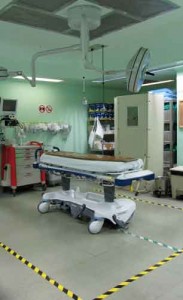
David and Donna H. recently took our healthcare tour and had this to say on one of the expat Facebook groups: Donna and I just finished the medical tour that Paul and Gloria (Retire For Less in Costa Rica) offer. It was excellent! Two days of information and tours around hospitals and clinics as well as educational and cultural centers and even information on some of the banking. The tour is designed to introduce a new arrival to the Costa Rican system of health care that includes, not just the body but the whole person. I highly recommend this tour to anyone that is new, or relatively new in-country, especially to the people that live in and around the central valley. Paul tailors the two days to the groups needs as far as their ability, including any and all physical limitations, and his own experience and contacts with the people at the various institutions make this tour extremely personable and pleasurable. It is a really great opportunity to learn more about the health care and how you can tailor it to your own needs, and learn more about what is available to enhance your experience while living in Costa Rica.”
We’ve lived in Costa Rica for more than 10 years and have used the Caja, Costa Rica’s public healthcare system extensively, as well as the private system when needed. We’ve learned the system and have been referred up the ladder to see specialists in the maze that is the Caja system. Gloria’s had out-patient surgery through the Caja and Paul was in a Caja hospital for 14 days to have his kidney removed after a cancer diagnosis. Our blend of personal insights and on-the-ground experience combines to answer your questions about whether or not Costa Rica’s healthcare system could meet your individual needs.
But, while it is focused on healthcare, you will learn a lot more about living and retiring in Costa Rica’s Central Valley. Most of the second day of the tour takes place in the town of San Ramón where we live and use the services. And you will come to our home that day to listen to two presentations.
Our tour is designed to save you both time and money, packing a lot of information into a short period of time. Our goal is to show you the possibilities and to try to demystify Costa Rica’s healthcare system. Our tour lasts two days and 1 night and includes lodging, transportation, meals, and non-alcoholic beverages.
Sample Itinerary
You’ll visit:
- At least two private hospitals in the San Jose area
- Hospital Mexico, the largest and best public hospital (they even do open heart surgeries there)
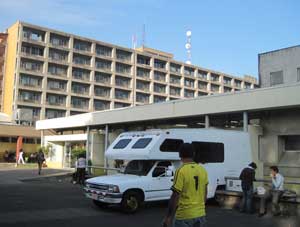
- An insurance broker for a presentation on the various supplemental health insurance options, including public, private, and international plans
- A senior living retirement community (optional)
- An in-patient drug-rehab facility (optional)
- CPI language school for a presentation about how learning Spanish increases your options for healthcare and some basic medical Spanish.
- Our local hospital here in San Ramón
- A local EBAIS (community clinic)
- A dental office in San Ramón
- A local Seguro Social office where you would sign up for the Caja (national healthcare coverage)
- A pharmacy
- A local feria (farmer’s market) where you will see the abundance of fresh food available.
- The local Cruz Roja (Red Cross) to learn about their services and programs.
- A health food store (macrobiotica), and more!
You’ll learn:
- If the Costa Rican healthcare system could meet your needs and put your mind to rest, once and for all, about this sensitive subject.
- About the public system and how it works, about the private healthcare system, and how you can use a combination of both to your advantage.
- About the EBAIS – where healthcare starts in Costa Rica.
- Approximately how much you would pay for Caja.
- About medical tourism in Costa Rica.
- About home health care in Costa Rica.
Prices: $650 for a couple, $550 for a single. Please contact us if you are interested in booking a tour. Space is limited.
Related Articles:
- Paul Gets a CAT Scan Through the Caja
- Integration 102 – Speaking Up at the Hospital
- Waiting to See the Doctor, by Jo Stuart
What About Oaxaca?
If you have been reading our website for a while, you know that we have been traveling to Oaxaca, Mexico, for the past seven years during part of Costa Rica’s rainy season. Paul went to University in Mexico and the country and its culture have always been an interest of his. I have come to love it as well. Spending several months in Oaxaca each year has given us the best of both worlds — the beauty, tranquility, and kind people of Costa Rica and the culture, arts, and great food of Mexico. Our plan is to continue to live part of the year in Costa Rica and part of the year in Oaxaca. In 2020, we will be in Costa Rica from January through June and in Oaxaca for the months of July through December.
 Facebook, Twitter, & YouTube
Facebook, Twitter, & YouTube



You can now follow us on Facebook and Twitter, so please “like” us on Facebook, “follow” us on Twitter, and watch and share our videos on YouTube.
What’s New on the Website
Check out our newest posts on www.retireforlessincostarica.com:
- My 2019 Healthcare Update, by Rob Evans
- What’s Up with the Yeatmans? – December 18, 2019
- In the Mailbag: Caja Payments, Retiring Overseas, Reading, and Cooking
- Our June 2019 Costa Rica Cost of Living
- Time, Happiness, and Seizing the Day
- Our May 2019 Costa Rica Cost of Living
- In the Mailbag: New Taxes, VPNs, and MediSmart
- Our April 2019 Costa Rica Cost of Living
- Healthcare Bang-for-Your-Buck
